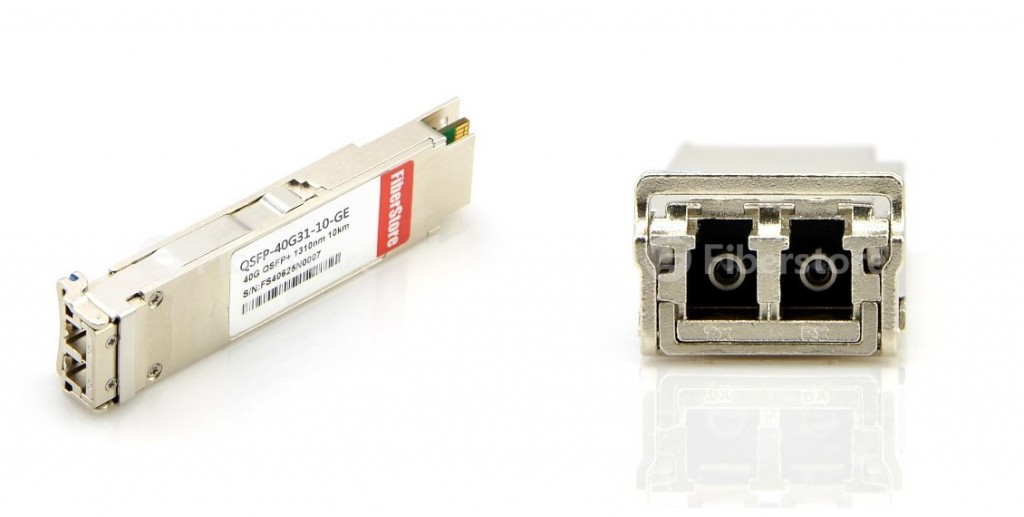10Gbps data rate can’t meet the high-speed needs. So people start to develop 40Gbps solutions. As a result, a variety of 40G QSFP+ transceivers can be found in the market, like QSFP-40G-SR4, QSFP-40G-CSR4, QSFP-40GE-LR4, QSFP-40G-LX4, etc. Different transceivers offer different ways to migrate from 10G to 40G. Among these solutions, which one is the most cost-effective? The answer is QSFP-40G-LX4. This following test will tell about QSFP-40G-LX4 in details.
QSFP-40G-LX4 Introduction
Juniper networks JNP-QSFP-40G-LX4 transceiver applies the new 40 Gigabit Ethernet technology — LX4 offered by Juniper. This transceiver module uses the same infrastructure as 10 GbE. The LX4 technology can meet all the performance criteria of today’s data centre in which two multimode fibre strands and duplex LC connectors are used for 40GbE connectivity just like existing 10GbE infrastructure.
As the above mentioned, QSFP-40G-LX4 transceiver provides the ability to transmit full-duplex 40Gbps data traffic over one duplex multimode fibre cable with LC connectors. In other words, this transceiver delivers 40 Gbps over duplex OM3 or OM4. It can achieve the direct connection from 10 Gbps to 40 Gbps through LC duplex fibre cable. The QSFP-40G-LX4 has four 10Gbps channels. Each channel can transmit and receive simultaneously on four wavelengths over a multimode strand (see the following figure). Thus, the 40Gbps link can be connected by two multimode strands. QSFP-40G-LX4 connections can support the data transmission distance up to 100 metres over OM3 and 150 metres over OM4.

QSFP+ LX4 Saving Cost
When preparing to migrate from 10G to 40G network, cost is one of the most important thing to be considered. As we know, existing 10Gbps connections commonly use MMF cables with LC connectors. While most 40Gbps connections often need eight fibre strands, each four parallel strands for transmitting and receiving respectively. Take QSFP-40G-SR4 an example, it uses 12-fibre MPO cable. Under that condition, 10Gbps cabling infrastructure should be upgraded to migrate to 40Gbps. It will cause additional cost of new patch cables, new patch panels, and expansion of the current fibre trunk.

However, QSFP LX4 transceiver can solve the cost issue. With QSFP-40G-LX4, it’s much easier to migrate from 10G to 40G network without considering the problem of deploying new cabling infrastructure or buying migration cassettes. Instead, it only needs to replace the 10GbE optical module with 40G-LX4. Because QSFP+ LX4 uses LC connectors. It allows the same cables to be used for direct 10 Gbps connections to direct 40 Gbps connections, resulting in zero-cost cabling migration. No additional spending on cabling will be required if QSFP+ LX4 transceivers are used for all 40 Gbps links. As a result, users realize 100 percent investment protection of their existing infrastructure and incur no additional cabling costs. This is a significant advantage when compared to the cost of reconstructing the cabling system using QSFP SR4 transceivers. If the cabling for this network is an expansion to the existing cabling system, the 40 Gbps connections can be built using MMF cables and QSFP SR4 transceivers or QSFP+ LX4 transceivers. QSFP+ LX4 can save a lot for 40 Gbps migration.
Conclusion
There are many solutions for the migration from 10G to 40G. QSFP+ LX4 technology removes 40 Gbps cabling cost barriers for migrating from 10 to 40 Gbps in data centre networks. QSFP+ LX4 transceivers provide 40 Gbps connectivity with huge cost savings and simplicity for next-generation data centre 40GbE deployments. The QSFP+ LX4 transceiver allows organizations to migrate their existing 10 Gbps infrastructure to 40 Gbps at zero cost of fibre, and to expand the infrastructure with low capital investment. FS.COM provides JNP-QSFP-40G-LX4 transceivers with high quality and 100% compatibility. All of transceivers have gone through test-assured program before reaching customers.
